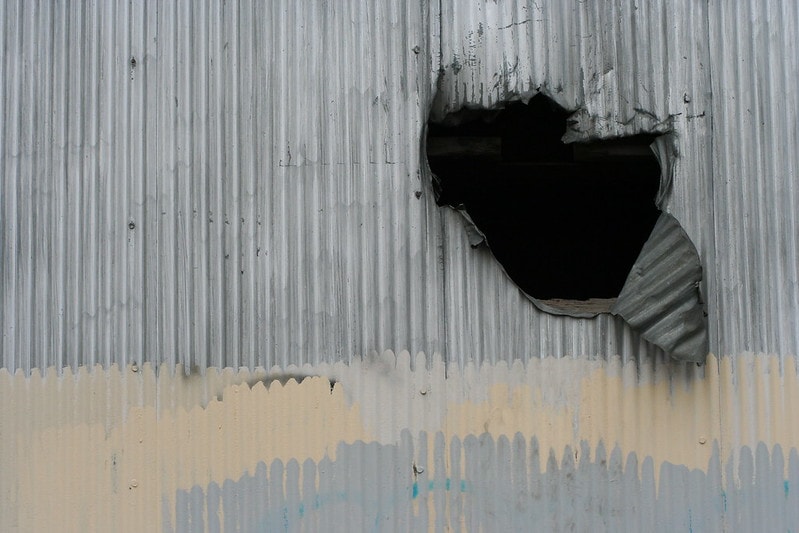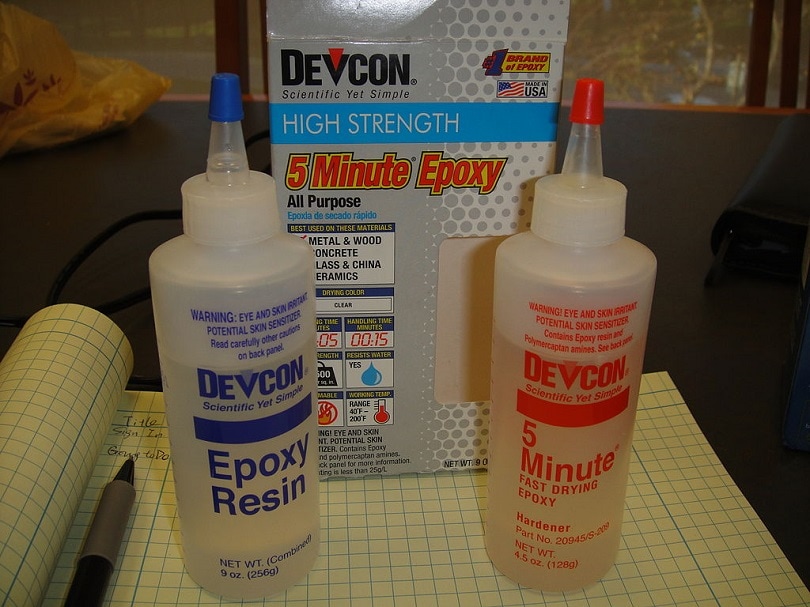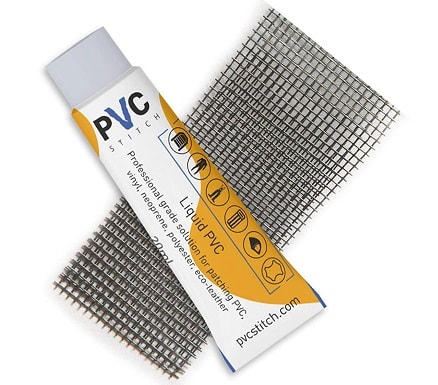How to Fill Holes in Metal without Welding (Quick & Easy)
Last Updated on

When holes form in your metal objects, what do you do? Which method do you use when it comes to filling these holes?
When fixing and rejoining metal objects, the best technique is welding. For instance, when joining two metal pieces, welding is the best method. However, you cannot apply it in specific conditions.
If holes still form in the metal, it’s advisable to use a distinct method. In this stage, a question on how to fill metal holes without welding arises. Some of the methods you can use are patching and use of epoxy by using thawed metal ore.
The application of these techniques differs by nature of the parent metal and the hole, and the parent metal size. In this article, we shall discuss the step-by-step guide on how to fill metal holes without welding. Let’s jump right in!
Epoxy or Tape

The two usual non-weld hole fixing options are epoxy and tape. These DIY techniques are efficient when fixing a small hole instead of a considerable tear. Tape merchandise and specialty epoxy are intended to patch metal and steel.
Sealing a hole using epoxy can at times be a lasting solution depending on the damage extent and the patch job quality. After sealing the epoxy, ensure that you apply a primer to the patched spot to stop reforming the hole.
Adhesive or aluminum tape is an easy and fast solution, especially for auto body damage. You can also paint it over to hide the repair work. However, if you use adhesive tape to repair holes in a car body or any other metal type, that’s considered a transient solution.
Use of Filling Agents

This technique is more fit than others because patching and epoxy aren’t sufficiently good if your solid object has holes.
During this procedure, the damaged section is heated up using a gas arc. Once it turns luminous red, pour the molten base metal into the holes and let it cool down gradually.
The molten metal serves as a filling agent. And, it creates a solid bond with the parent metal. However, the application will make the surface stiff and you can use a baby sander or sandpaper to make it sleek.
The technique is somewhat dangerous. When doing this, adhere to the safety measures. Ensure that your hands are covered when adding the filling agent. To carry out this method, a professional is needed. Also, it’s more intricate and expensive as compared to the other two methods.
Use a UV Repair Patch

Try a UV patch to fix holes in metal without welding if you want a more long-lasting and permanent method of repairing holes. When it comes to damage from rust or small holes, UV repair patches are almost immediate fixes that’ll get you back up and operating fast.
In UV repair patches, you apply the patch to the hole or rusted spot and wait for the sun’s Ultra-Violet rays to actuate the patch, hardening it in a couple of minutes after the first exposure. UV patches can be actuated and treated with UV light emitted from a lamp if you’re working in a dark area and there’s no access to the sun.
UV repair patches are a supple material similar to clothes that can adapt to any surface for a precise fit. As industrial glue, they create permanent bonds with the metal surface, providing a durable, non-weld hole repair.
You don’t have to be concerned with leaks or extra rust as these UV repair patches are waterproof. Metal repair patches are also oil and corrosion-resistant and don’t wear out if continuously exposed to UV light.
Applying, sanding, and painting takes less than an hour from beginning to end. It implies that applying a UV repair patch is a fast procedure.
If you’re wondering how to fill holes in metal without welding, then take into account the following applications of metal repair patches.
UV Repair Patches Applications
When it comes to instant metal repair, UV repair patches are versatile solutions. It’s compatible with numerous distinct merchandise and surfaces and there are infinite applications for immediate repair patches.
Irrespective of whether you’re repairing something around your household, carrying out autobody repairs, or filling holes in agricultural or industrial gear, UV repair patches are the ideal solution for your situation.
- Automobiles
If you want to carry out auto-body repairs, you may think that there’s only one way (welding a hole) to have a lasting, powerful patch. UV repair patches actuated by UV light are a pocket-friendly and expedient alternative to repair holes in a vehicle’s body.
UV repair patches repair corroded fuel tanks or bumpers and mend holes in radiators, fenders, and mufflers. You can apply the adhesive formula on either the inside or the outer side of metal or fiberglass bodies. UV repair patches are also excellent for motorcycles, trailers, and RVs.
- Industries
Industrial environments are harsh and violent. It causes wear and tear even on the sturdiest surfaces. If your pipes, metal ducting, or tanks have developed holes, a UV repair patch can offer a premium quality repair within a short time.
If there are small holes or corroded areas in HVAC equipment, apply a UV repair as it’ll provide a high-quality, long-lasting solution without welding.
- Agriculture
Abrupt damage to agricultural gear leads to expensive interruptions to a business. If your grain handling equipment develops a hole, it’s crucial to have it repaired as fast as possible. UV actuated repair patches are necessary as they come in handy at any agricultural operation.
Replacing agricultural gear and grain bins is costly. By making pocket-friendly and permanent repairs using UV patches, you’ll preserve your investment. With instant UV repair patches, you’ll mend holes in your elevator trunking, grain bins, and other grain handling gear fast. It’ll help you get back into operation with restricted downtime.
- Around the Home
Homeowners understand that continuing yard and house maintenance is necessary to avoid expensive damage and maintain the value of your home. To be always on top of your to-do list, ensure that instant UV repair patches are available when carrying out ongoing maintenance around your home.
You can use UV repair patches on destroyed shed or garage doors, and metal sidings and gutters as well.
Also, you can use UV repair patches to repair sports or avocation gear such as surf and snowboards, kayaks, and canoes. With the UV repair patches, you can also fix damaged pool gear or yard pipes.
1. Prepare the Hole
Use coarse sandpaper to get rid of dirt, corrosion, oil, and paint from the metal surroundings. Do this in a considerably less broad 1-inch border around the hole you’re repairing on both sides of the metal.
Use a putty knife or applicator supplied with the whole kit for the covering purposes with epoxy filler. You can also use the putty knife to press the epoxy. The edges of the fiberglass screen piece slice around 1-inch bigger than the hole. Ensure you cure the epoxy as per the manufacturer’s directions.
2. Fill the Entire Hole
Epoxy covers the whole process from the front side working. You can use a hard piece of cardboard, a kit applicator, or a putty knife. Make sure that you apply epoxy until the entire hole is filled or repaired.
Epoxy will form over the metal surface and the edges of the hole will overlap a bit. Allow the epoxy to harden.
3. Sand the Whole Patch
You can use sandpaper (manufactured from silicon carbide) to reduce the desiccated epoxy that’s surrounding the metal level. A power sander can speed up the entire process.
To form a glass-smooth patch, use 80-grit sandpaper, followed by a 300-grit or 200-grit sander.
4. Coat the Whole Patch
To dispose of sand and dust, clean the patch using a cloth that’s soft and drenched in alcohol. Then, spray the whole patch with primer. Hold the can about 6 inches from the metal surface and gradually move it in a straight line from the side. Ensure that you don’t push it into the arc.
You may also be interested in: How to MIG Weld Aluminum: Full Guide with 15 Tips & Tricks
What would happen if the hole is on the roof? How do you repair it? Well, here are the steps.
1. Clean the Repair Spot
Cleaning the surface is the first step in repairing metal roofing. Several things can cause a hole in a metal roof system. It could be from corrosion or deterioration or it can be from something that falls on the roof surface.
Wipe the metal surface thoroughly using Simple Green or any other cleaner. Ensure that the surface is free from algae growth or dust. Any residue will affect the roof repair integrity.
2. Scrape the Metal
As soon as you’re through cleaning the metal surface, rub the surface to be repaired with a wire brush. Scraping the surface helps create a bond between the metal and the sealant. Ensure you use the wire brush only at the spot you’re intending to patch. If you brush beyond, you may get rid of the protective covering from the metal surface, leading to deterioration later.
3. Measure the Repair Spot and Slice a Patch
Cut the selected metal to a size suitable for the spot to be mended. Ensure that the sheet metal extends over the metal panel by at least two inches past the damaged spot’s edges.
Once you’re through with cutting and fitting the metal sheet into size, use a file or emery cloth to round the patch’s corners. It stops any sharp nooks from becoming catching areas for ice or snow.
After measuring the patch, put it over the hole you’re repairing. Ensure that the patch extends by two inches in every direction past the damaged spot.
4. Mount the Repair Patch
On the surface of the metal plate to be patched, apply a color-matched urethane sealant. Make sure you apply the sealant generously to the spot. This way, there won’t be gaps or voids in the patch’s leading edge.
Press the patch into position over the damaged spot. The sealant pushes out from the edge of the patch on all sides.
5. Secure the Patch
After pressing the patch into position, fix it to the metal roof panel surface with pan-head sheet metal screws. Ensure that the screws are spaced at 3-4 inches around the patch’s perimeter. Put the screws within one inch of the patch’s edges. This way they’ll apply even pressure to the sealant under the patch and the edges.
To secure the patch to the roofing panel lying underneath, ensure the screws are sufficiently long. After the patch is mounted, it’s crucial to make sure that you use a putty knife to adjust any sealant that may be oozing from the edge of the patch.
It makes sure that no moisture enters and the sealant seals the edges of the patch well. Allow the sealant to desiccate as instructed in the product directions. It can take a day or two to dry completely.
6. Paint the Patch to Correspond to the Roof
You can paint the patch surface to match the color of the metal roof panels if you want to. Brush the metal patch surface and the metal panel slightly past the edges. Paint over the patch surface and on the underlying panel surface.
It’s crucial to wait for the sealant to cure completely before painting. Also, make sure that the paint is suitable for the sealant used.
What’s Your Preferred Method of Filling Holes in Metal without Welding?
The best technique is welding of course. However, it’s an expensive method and can be too risky. The welder also requires intensive care because of its high voltage electric circuit. If you want to get an answer on how to fill holes in metal without welding, then these methods, the step-by-step guide, and where it’s applied will be useful to you.
They’re simple and convenient methods for everyone and are less risky than welding. Choose a suitable method depending on the metal objects.
Featured image credit: Lars Hammar, Flickr
